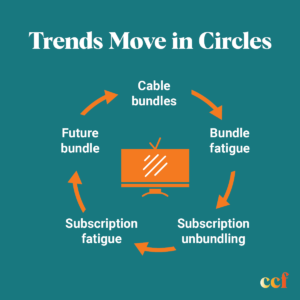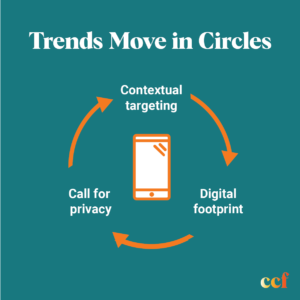Welcome to Media Trends Monday, a new series designed to give you insight into current trends in media, how they’ll impact your organization, and how we view the big picture landscape here at CCF.
We aren’t here to reinvent the wheel, but we are here to observe it. And today we’d like to examine a particularly fascinating one.
The cyclical trend of cable bundling
Trends are cyclical, and in the realm of TV, that is especially true. Let’s start with the rise of cable. Cable was a way to get a bundle of media outlets delivered to your TV set for a flat rate.

Cable reached its peak in around 2012, with over 100 million subscribers nationwide. But then the public started to experience bundle fatigue; they were sick of being forced into unbreakable cable TV and internet bundles with ever-changing rates. Cable subscriptions have now declined to under 80 million.
That bundle fatigue coincided with the rise of streaming services such as Netflix and Hulu, and a mass “unbundling” occurred, a practice we know as “cord cutting”.
Many households began to stream their shows and movies from a combination of these services (does anyone have a Paramount Plus password I can borrow?). Seemingly every single media corporation got in on the “streaming wars” and we’ve all witnessed it firsthand. Now, there are so many services that we’re experiencing subscription fatigue.
As a result, we’re seeing streaming giants like Disney sell subscription services together as a bundle, just like the cable companies did all those years ago. What goes around comes around, right?
Still, drawing a perfect circle is almost impossible unless you’re this person:

The return of contextual targeting
Not to be outdone, media trends drew another circle. It started with the contextual targeting that advertisers use every day to get to know you better. With powerful tools like cookies, brands can know more about you than even your friends do.

Yes, your favorite brands love cookies, and why wouldn’t they? They’re delicious. And much like someone who eats too many real-life cookies, our collection of personal data on the internet (digital footprint) has ballooned to alarmingly husky proportions.
In response, America decided that it was time to lose some digital weight and gain some much needed privacy in the process. So we’re making data protection laws.
And of course to keep up, brands will have to change how they target consumers. So to get back to square one (or circle one?), Google is totally changing how they do contextual targeting.
But how does this all pertain to my business? And what do I need to do to ensure my messages reach the right people? We’re here to help you answer those questions. Let’s talk.
We’ll dive more into more trends in TV, mobile, digital, and traditional in the coming weeks. To start though, we believe that in order to succeed on a micro level, it’s important to understand big picture trends too. Alexa, play Circles by Post Malone.



